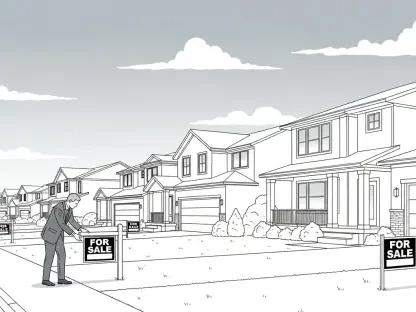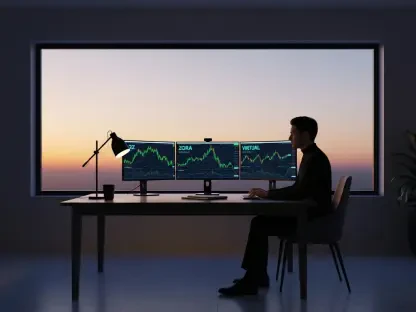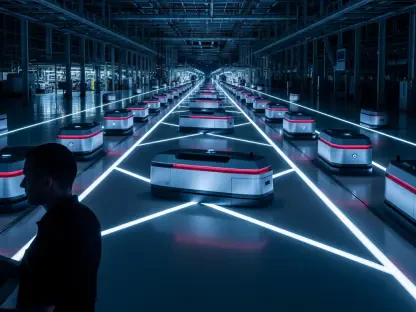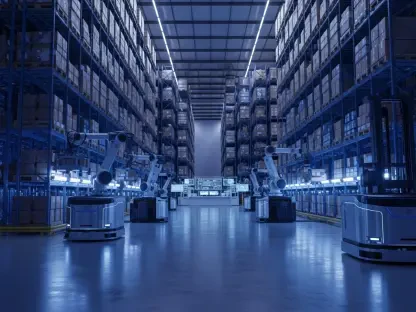In a remarkable stride for the agricultural technology sector, SAIA Agrobotics, a pioneering Dutch company headquartered in Ede, Netherlands, has successfully garnered €10 million in Series A funding to transform the landscape of greenhouse automation. Established in 2017, this innovative firm is confronting some of the most critical issues plaguing modern agriculture, including persistent labor shortages and the escalating need for sustainable food production. By introducing a revolutionary system that transports plants to stationary robots for precise tasks such as scanning and harvesting, SAIA is redefining efficiency and accuracy in controlled-environment farming. This approach not only addresses immediate industry challenges but also positions the company as a frontrunner in meeting the global demand for fresh, locally sourced produce, which is projected to increase by 30-50% in the coming decades. With early adoption by clients like Growers United, SAIA’s technology is already showing tangible promise, setting the stage for a broader impact on food security and sustainability.
Innovating Greenhouse Automation
Revolutionizing Plant Handling
SAIA Agrobotics has carved a niche in the AgTech arena with a groundbreaking model that inverts the conventional dynamics of agricultural robotics. Rather than deploying robots to navigate through greenhouse aisles to tend to crops, SAIA’s system brings plants directly to stationary robots for critical operations like de-leafing, scanning, and harvesting. This innovative setup creates a standardized environment where robots can perform with an astonishing accuracy rate of over 99%, as highlighted by industry experts involved in the funding round. Such precision ensures consistent product quality while significantly minimizing errors that often plague manual or mobile robotic processes. The result is a streamlined workflow that not only enhances the reliability of greenhouse operations but also sets a new benchmark for technological integration in agriculture. This unique approach is particularly timely given the pressing labor constraints faced by high-tech horticulture sectors globally, where efficiency is paramount.
The implications of SAIA’s design extend far beyond mere accuracy, offering a substantial boost to overall productivity in greenhouse settings. By achieving a fully automated greenhouse—the first of its kind worldwide—the company has demonstrated the potential to increase crop yields by an impressive 20%. Simultaneously, the system slashes labor requirements by 50%, addressing one of the most significant bottlenecks in modern agriculture: the availability and cost of skilled workers. This dual benefit of enhanced output and reduced human dependency makes SAIA’s technology a compelling solution for growers aiming to scale operations sustainably. Early implementations with partners like Growers United underscore the practical viability of this model, showing that it can seamlessly integrate into existing frameworks while delivering measurable improvements. As the demand for fresh produce continues to soar, SAIA’s innovation offers a glimpse into a future where automation could redefine food production on a global scale.
Scaling Efficiency Through Technology
Another critical aspect of SAIA’s automation system is its capacity to optimize greenhouse conditions for year-round productivity. By enabling consistent harvesting 52 weeks a year, the technology ensures that growers are no longer constrained by seasonal labor fluctuations or environmental variables. This continuous operation is a game-changer for regions like the Netherlands, where high-tech greenhouse horticulture leads the world in cultivating crops such as tomatoes, cucumbers, and peppers. The ability to maintain steady output regardless of external challenges not only boosts profitability for growers but also contributes to more resilient local food supplies. Such advancements align closely with broader societal goals of sustainability, as they reduce waste and maximize resource efficiency in controlled environments, paving the way for a more predictable agricultural ecosystem.
Moreover, SAIA’s focus on digitization within its automation framework adds another layer of sophistication to greenhouse management. The integration of advanced scanning and data collection by stationary robots allows for real-time monitoring of plant health and growth patterns, enabling growers to make informed decisions swiftly. This data-driven approach minimizes guesswork, ensuring that every aspect of cultivation—from nutrient delivery to harvest timing—is fine-tuned for optimal results. Unlike traditional methods that often rely on periodic human assessments, SAIA’s system provides a continuous feedback loop that enhances precision at every stage. As the company prepares for wider commercial deployment, this technological edge positions it to address not just current industry pain points but also future challenges in scaling sustainable food production to meet global needs.
Funding Success and Investor Support
Capitalizing on a Visionary Model
The recent €10 million Series A funding round, led by Check24 and supported by the European Innovation Council (EIC) Fund alongside existing investors like Navus Ventures and Oost NL, marks a pivotal moment for SAIA Agrobotics. This substantial financial injection brings the company’s total funding to over €20 million, reflecting robust confidence in its potential to reshape sustainable food production through cutting-edge automation. The capital is strategically allocated to accelerate the commercial rollout of SAIA’s greenhouse system, with market entry targeted for 2026. Investors have lauded the transformative nature of the technology, emphasizing its capacity to address critical inefficiencies in agriculture while aligning with European priorities for environmental stewardship. This backing is not merely financial but a testament to the belief that SAIA can lead a paradigm shift in how controlled-environment farming operates on a global stage.
Beyond the monetary support, the diverse investor base underscores the wide-ranging appeal of SAIA’s vision. Stakeholders from various sectors, including deep-tech and impact-focused funds, recognize the company’s roots in Wageningen University & Research—a globally respected center for agricultural innovation—as a strong foundation for success. Their endorsement highlights SAIA’s readiness to transition from research and development to full-scale commercialization, building on years of technological refinement. The involvement of entities like the EIC Fund further signals alignment with broader policy goals to foster sustainable agricultural advancements across Europe. As SAIA leverages this funding to expand its reach, the investment serves as a catalyst for scaling a solution that promises to mitigate labor shortages and enhance food security, positioning the company as a key player in the AgTech revolution.
Building Momentum for Market Impact
The enthusiasm surrounding SAIA’s funding reflects a deeper conviction in the scalability of its automation model to address pressing global challenges. Investors have pointed to the system’s innovative plant-handling logistics as a cornerstone of its potential to redefine efficiency in greenhouse farming. This perspective is grounded in the tangible outcomes already observed, such as significant labor cost reductions and improved harvest consistency, which are critical for growers facing economic pressures. The strategic plan to deploy this technology commercially by 2026 is seen as a realistic timeline, given the early validation from initial customers and the robust support from a committed investor network. Such momentum suggests that SAIA is not just responding to current market needs but proactively shaping the future of sustainable agriculture with a solution that balances profitability and societal benefit.
Additionally, the funding success situates SAIA within a vibrant European AgTech investment landscape, where automation and digitization are increasingly prioritized. The company’s achievements parallel other notable 2025 funding rounds, underscoring a collective investor appetite for technologies that enhance agricultural resilience. This broader context amplifies the significance of SAIA’s €10 million raise, as it contributes to a growing ecosystem of innovation aimed at tackling systemic issues like labor scarcity and rising food demand. By aligning with these trends, SAIA is poised to benefit from shared knowledge and market opportunities, further strengthening its position as a leader in greenhouse automation. As the company moves forward, this financial and strategic support will be instrumental in navigating the complexities of market entry and scaling impact across diverse agricultural regions.
Broader AgTech Trends and Challenges
Investment Surge in Digital Farming
SAIA Agrobotics’ recent funding triumph is emblematic of a larger wave of investment sweeping through the European AgTech sector in 2025. Comparable milestones, such as Saga Robotics securing €9.5 million for its autonomous farm-robot platform and Wild Bioscience raising €51 million for AI-driven precision-breeding technology, highlight a sustained investor interest in digital solutions that elevate agricultural productivity. These developments reflect a shared recognition of the urgent need to modernize food production systems in response to global population growth and environmental pressures. SAIA’s €10 million Series A round fits seamlessly into this narrative, reinforcing the notion that automation and digitization are no longer optional but essential for the future of farming. This collective momentum suggests a transformative period for the industry, where technological innovation is becoming the backbone of sustainable agricultural progress.
The focus on digital farming solutions also underscores a strategic shift toward addressing systemic inefficiencies that have long hindered agricultural scalability. Investors are increasingly drawn to technologies that promise not only economic returns but also environmental benefits, such as reduced resource waste and lower carbon footprints. SAIA’s model, with its emphasis on precision and labor reduction, aligns perfectly with these priorities, positioning it as a key contributor to the evolving AgTech landscape. The company’s success in attracting diverse funding sources further illustrates the broad appeal of solutions that tackle real-world challenges like food security through scalable innovation. As this investment trend continues, it is likely to spur further advancements, creating a ripple effect that could reshape global agriculture by prioritizing efficiency and sustainability in equal measure.
Tackling Industry Hurdles
Dutch greenhouse horticulture, a global leader in high-tech cultivation of crops like tomatoes and peppers, faces mounting challenges that SAIA’s technology is uniquely equipped to address. With labor costs soaring and skilled workers becoming increasingly scarce, the sector struggles to maintain its competitive edge despite an anticipated demand for thousands of hectares of new greenhouse projects annually. SAIA’s automation system offers a timely solution by slashing labor requirements by 50%, thereby alleviating the economic burden on growers while maintaining high output levels. This reduction in human dependency is particularly critical in a market where operational costs threaten to outpace profitability, making technologies like SAIA’s not just desirable but indispensable for sustaining growth in controlled-environment agriculture.
Furthermore, the broader implications of labor shortages extend beyond economics to the very resilience of food supply chains, a concern amplified in regions reliant on greenhouse production. SAIA’s ability to enable consistent, year-round harvesting through automation mitigates the risks associated with workforce variability, ensuring that production remains unaffected by external disruptions. This stability is vital for meeting the rising global demand for fresh produce, which requires innovative solutions to bridge the gap between supply and need. By optimizing growing conditions and harvest frequency, SAIA’s system also contributes to environmental sustainability, reducing the need for expansive land use and minimizing waste. As the industry grapples with these multifaceted challenges, SAIA stands out as a beacon of how targeted technological interventions can address both immediate operational hurdles and long-term strategic goals.
Reflecting on a Path Forward
Looking back, SAIA Agrobotics’ €10 million Series A funding round and the development of its pioneering greenhouse automation system marked a defining moment in the AgTech sector. The company’s ability to secure substantial investor support while demonstrating real-world impact through early client adoption spoke volumes about its potential to address critical issues like labor shortages and yield inefficiencies. As SAIA prepared for a commercial launch targeted for 2026, the focus shifted to actionable next steps, including refining the technology for diverse greenhouse environments and expanding partnerships with growers worldwide. This strategic roadmap, bolstered by a cumulative funding of over €20 million, highlighted a clear path toward scaling sustainable food production. The journey underscored the power of innovation to transform agriculture, offering a blueprint for how automation could ensure food security in an era of growing demand and resource constraints.









